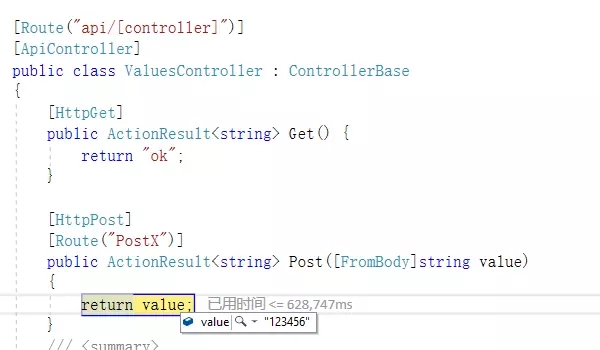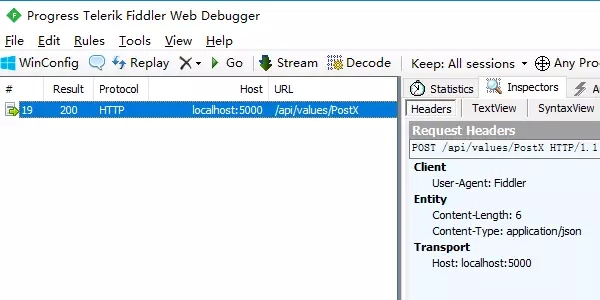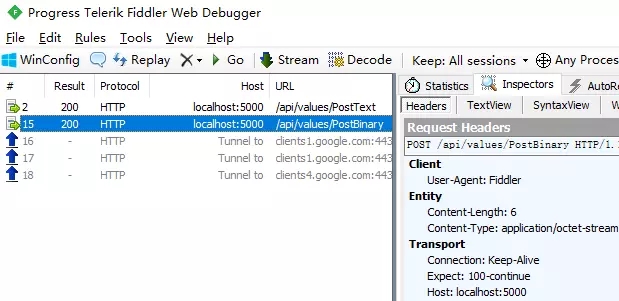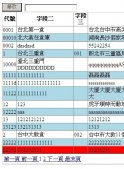主要目標
在Asp.net Core控制器中,通過自定義格式化程序來映射自定義處理控制器中的“未知”內容。本文將給大家詳細介紹關于Asp.Net Core控制器接收原始請求正文內容的相關內容,分享出來供大家參考學習,下面話不多說了,來一起看看詳細的介紹吧
簡單案例
為了演示這個問題,我們用VS2017創(chuàng)建一個默認的Asp.net Core Web Api項目。
|
1
2
3
4
5
6
7
8
9
10
11
12
13
14
15
|
[Route("api/[controller]")][ApiController]public class ValuesController : ControllerBase{[HttpGet]public ActionResult<string> Get() { return "ok";}[HttpPost][Route("PostX")]public ActionResult<string> Post([FromBody] string value){ return value;}} |
Json請求
我們從最常見的json輸入請求開始。
|
1
2
3
4
|
User-Agent: FiddlerHost: localhost:5000Content-Type: application/jsonContent-Length: 16 |
請求body:
|
1
|
{"123456"} |
通過后臺調試和fiddler抓包,我們可以看到請求輸入和返回。

后臺調試,查看請求輸入結果

fiddler查看請求header

fiddler查看返回結果
注意!!
別忘了[FromBody],有時候會忘的。
后臺action接收類型為string的時候,請求body只能是字符串,不能傳json對象。我演示這個例子時,被這點坑了。如果接收對象是一個類的時候,才可以傳json對象。
沒有JSON
雖然傳輸json數據是最常用的,但有時候我們需要支持普通的文本或者二進制信息。我們將Content-Type改為
text/plain
|
1
2
3
4
|
User-Agent: FiddlerHost: localhost:5000Content-Type:text/plainContent-Length: 16 |
請求body:
|
1
|
{"123456"} |
悲劇的事情來,報404!

不支持text/plain
事情到此就變得稍微復雜了一些,因為asp.netcore只處理它認識的類型,如json和formdata。默認情況下,原始數據不能直接映射到控制器參數。這是個小坑,不知你踩到過沒有?仔細想想,這是有道理的。MVC具有特定內容類型的映射,如果您傳遞的數據不符合這些內容類型,則無法轉換數據,因此它假定沒有匹配的端點可以處理請求。
那么怎么支持原始的請求映射呢?
支持原始正文請求
不幸的是,ASP.NET Core不允許您僅通過方法參數以任何有意義的方式捕獲“原始”數據。無論如何,您需要對其進行一些自定義處理Request.Body以獲取原始數據,然后對其進行反序列化。
您可以捕獲原始數據Request.Body并從中直接讀取原始緩沖區(qū)。
最簡單,最不易侵入,但不那么明顯的方法是使用一個方法接受沒有參數的 POST或PUT數據,然后從Request.Body以下位置讀取原始數據:
讀取字符串緩沖區(qū)
|
1
2
3
4
5
6
7
8
9
|
[HttpPost][Route("PostText")]public async Task<string> PostText(){ using (StreamReader reader = new StreamReader(Request.Body, Encoding.UTF8)) { return await reader.ReadToEndAsync(); }} |
這適用于一下Http和文本
|
1
2
3
4
|
User-Agent: FiddlerHost: localhost:5000Content-Type: text/plainContent-Length: 6 |
要讀取二進制數據,你可以使用以下內容:
讀取byte緩沖區(qū)
|
1
2
3
4
5
6
7
8
9
10
|
[HttpPost][Route("PostBinary")]public async Task<byte[]> PostBinary(){ using (var ms = new MemoryStream(2048)) { await Request.Body.CopyToAsync(ms); return ms.ToArray(); // returns base64 encoded string JSON result }} |
查看執(zhí)行結果

接收文本內容

接收二進制數據
HttpRequest靜態(tài)擴展
如果你為了方便,寫了很多HttpRequest的擴展,接收參數時,可以看起來更簡潔一些。
|
1
2
3
4
5
6
7
8
9
10
11
12
13
14
15
16
17
18
19
20
21
22
23
24
25
26
27
28
29
30
31
32
33
34
35
36
37
38
39
40
41
42
43
|
public static class HttpRequestExtension { /// <summary> /// /// </summary> /// <param name="httpRequest"></param> /// <param name="encoding"></param> /// <returns></returns> public static async Task<string> GetRawBodyStringFormater(this HttpRequest httpRequest, Encoding encoding) { if (encoding == null) { encoding = Encoding.UTF8; } using (StreamReader reader = new StreamReader(httpRequest.Body, encoding)) { return await reader.ReadToEndAsync(); } } /// <summary> /// 二進制 /// </summary> /// <param name="httpRequest"></param> /// <param name="encoding"></param> /// <returns></returns> public static async Task<byte[]> GetRawBodyBinaryFormater(this HttpRequest httpRequest, Encoding encoding) { if (encoding == null) { encoding = Encoding.UTF8; } using (StreamReader reader = new StreamReader(httpRequest.Body, encoding)) { using (var ms = new MemoryStream(2048)) { await httpRequest.Body.CopyToAsync(ms); return ms.ToArray(); // returns base64 encoded string JSON result } } } } |
|
1
2
3
4
5
6
7
8
9
10
11
12
13
14
15
16
|
[HttpPost][Route("PostTextX")]public async Task<string> PostTextX(){ return await Request.GetRawBodyStringAsyn();}/// <summary>/// 接收/// </summary>/// <returns></returns>[HttpPost][Route("PostBinaryX")]public async Task<byte[]> PostBinaryX(){ return await Request.GetRawBodyBinaryAsyn();} |
自動轉換文本和二進制值
上面雖然解決了原始參數轉換問題,但不夠友好。如果你打算像原生MVC那樣自動映射參數的話,你需要做一些自定義格式化適配。
創(chuàng)建一個Asp.net MVC InputFormatter
ASP.NET Core使用一種干凈且更通用的方式來處理內容的自定義格式InputFormatter。輸入格式化程序掛鉤到請求處理管道,讓您查看特定類型的內容以確定是否要處理它。然后,您可以閱讀請求正文并對入站內容執(zhí)行自己的反序列化。
InputFormatter有幾個要求
- 您需要使用[FromBody]去獲取
- 您必須能夠查看請求并確定是否以及如何處理內容。
在這個例子中,對于“原始內容”,我想查看具有以下類型的請求:
- text/plain(文本)
-
appliaction/octet-stream(byte[])
沒有內容類型(string)
要創(chuàng)建格式化程序,你可以實現IInputFormatter或者從InputFormatter繼承。
|
1
2
3
4
5
6
7
8
9
10
11
12
13
14
15
16
17
18
19
20
21
22
23
24
25
26
27
28
29
30
31
32
33
34
35
36
37
38
39
40
41
42
43
44
|
public class RawRequestBodyFormatter : IInputFormatter{ public RawRequestBodyFormatter() { } public bool CanRead(InputFormatterContext context) { if (context == null) throw new ArgumentNullException("argument is Null"); var contentType = context.HttpContext.Request.ContentType; if (string.IsNullOrEmpty(contentType) || contentType == "text/plain" || contentType == "application/octet-stream") return true; return false; } public async Task<InputFormatterResult> ReadAsync(InputFormatterContext context) { var request = context.HttpContext.Request; var contentType = context.HttpContext.Request.ContentType; if (string.IsNullOrEmpty(contentType) || contentType.ToLower() == "text/plain") { using (StreamReader reader = new StreamReader(request.Body, Encoding.UTF8)) { var content = await reader.ReadToEndAsync(); return await InputFormatterResult.SuccessAsync(content); } } if (contentType == "application/octet-stream") { using (StreamReader reader = new StreamReader(request.Body, Encoding.UTF8)) { using (var ms = new MemoryStream(2048)) { await request.Body.CopyToAsync(ms); var content = ms.ToArray(); return await InputFormatterResult.SuccessAsync(content); } } } return await InputFormatterResult.FailureAsync(); }} |
格式化程序用于CanRead()檢查對內容類型的請求以支持,然后將ReadRequestBodyAsync()內容讀取和反序列化為應在控制器方法的參數中返回的結果類型。
InputFormatter必須在ConfigureServices()啟動代碼中注冊MVC :
|
1
2
3
4
|
public void ConfigureServices(IServiceCollection services) { services.AddMvc(o=>o.InputFormatters.Insert(0,new RawRequestBodyFormatter())).SetCompatibilityVersion(CompatibilityVersion.Version_2_1); } |
接受原始輸入
|
1
2
3
4
5
6
|
[HttpPost][Route("PostTextPlus")]public string PostTextPlus([FromBody] string value){ return value;} |
然后你就可以發(fā)送post請求,像這樣:
|
1
2
3
|
User-Agent: FiddlerHost: localhost:5000Content-Length: 6 |
或者
|
1
2
3
4
|
User-Agent: FiddlerHost: localhost:5000Content-Type:text/plainContent-Length: 6 |
請注意,您可以使用內容類型調用相同的控制器方法application/json并傳遞JSON字符串,這也將起作用。在RawRequestBodyFormatter 簡單地增加它支持的附加內容類型的支持。
二進制數據
|
1
2
3
4
5
6
|
[HttpPost][Route("PostBinaryPlus")]public byte[] PostBinaryPlus([FromBody] byte[] value){ return value;} |
請求內容如下:
|
1
2
3
4
|
User-Agent: FiddlerHost: localhost:5000Content-Length: 6Content-Type: application/octet-stream |
源代碼
示例代碼已上傳到 CsharpFanDemo
參考鏈接
本文包含翻譯和自己實踐。主要思路和代碼來源于以下鏈接:
Accepting Raw Request Body Content in ASP.NET Core API Controllers
總結
以上就是這篇文章的全部內容了,希望本文的內容對大家的學習或者工作具有一定的參考學習價值,如果有疑問大家可以留言交流,謝謝大家對服務器之家的支持。
原文鏈接:https://www.jianshu.com/p/4a96d73428dc












